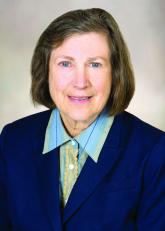News

Change is upon us
- Author:
- Karen E. Deveney, MD, FACS
Most of us dread change, because of our natural apprehension of the unknown.
News

From the Editors: Surgical M&M – a lost art?
- Author:
- Karen E. Deveney, MD, FACS
The M&M is an educational venue from which all in attendance learn from the misadventures of others.
Opinion

From the Editors: The Value of Community
- Author:
- Karen E. Deveney, MD, FACS
To those of you who rarely (or never) have attended a ACS chapter meeting, you need to go.
News

Gender equity in surgery: It’s complicated
- Author:
- Karen E. Deveney, MD, FACS
Implicit and explicit bias remain important reasons why only a minority of female medical students choose surgery as a career in 2018.
News

From the Editors: “Okay” is not good enough
- Author:
- Karen E. Deveney, MD, FACS
Institutions and medical device manufacturers are increasingly requiring proctoring of established surgeons who are adopting new procedures.
News

From the Editors: An unexpected call to action
- Author:
- Karen E. Deveney, MD, FACS
Sometimes we have to step out of our comfort zone and answer a call for help.
Opinion

From the Editors: Finding joy
- Author:
- Karen E. Deveney, MD, FACS
Take some time to reflect, renew, and recharge.
Opinion

From the Editors: Hanging up the scalpel
- Author:
- Karen E. Deveney, MD, FACS
The decision to stop practicing surgery is a monumental one when you have been a surgeon for almost 40 years, have loved operating, and have...
Opinion

From the Editors: A crisis of confidence?
- Author:
- Karen E. Deveney, MD, FACS
As today’s surgical residents complete their residencies and enter practice, we are compelled to ask, Is their level of confidence and...
Opinion

Acute cholecystitis: Not always routine
- Author:
- Karen E. Deveney, MD, FACS
All cholecystectomies are not routine.
Opinion

Doing a lot with little – health care in Cuba
- Author:
- Karen E. Deveney, MD, FACS
Cuba’s health care system has been touted as providing universal access to primary care services, whose goals are promoting health and preventing...
Article

Strength in Community
- Author:
- Karen E. Deveney, MD, FACS
If there was ever a need to reach out and communicate with one another and understand that the overwhelming desire of every surgeon is to provide...
Article

From the Editors: The Clinical Congress: Something for everyone
- Author:
- Karen E. Deveney, MD, FACS
In this issue of ACS Surgery News, you will see articles highlighting the program of the ACS Clinical Congress that took place in Washington, D.C...
Article

From the Editors: Querencia
- Author:
- Karen E. Deveney, MD, FACS
- Tyler G. Hughes, MD, FACS
The Editors of ACS Surgery News want to provide a querencia: a source of reliable, vetted information that gives surgeons a place of intellectual...
Opinion
The future of surgery
- Author:
- Karen E. Deveney, MD, FACS
